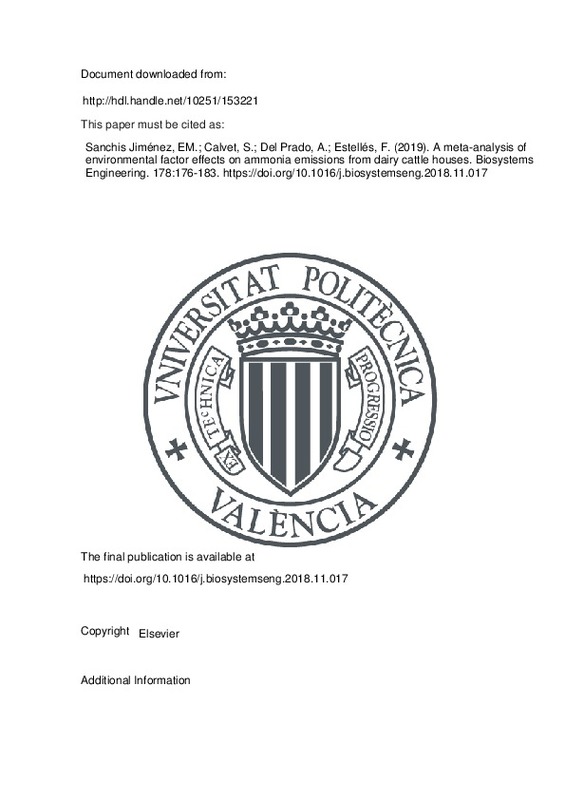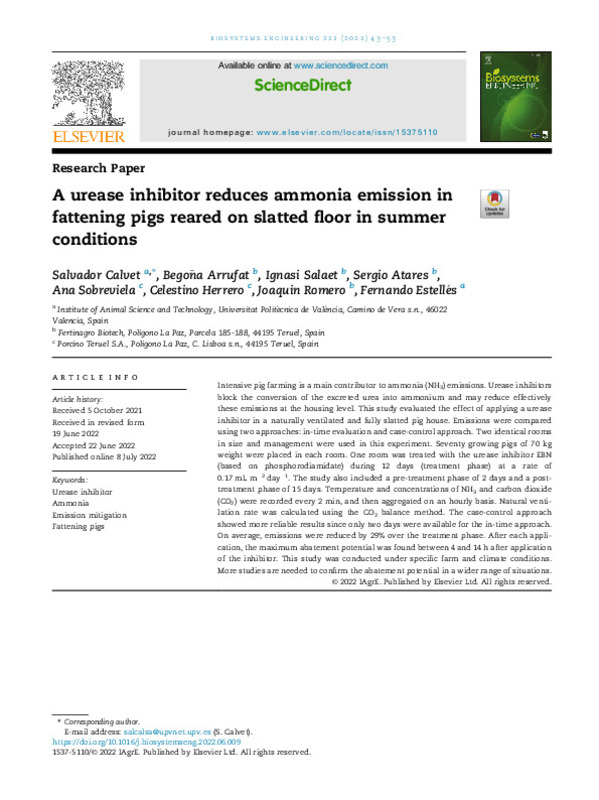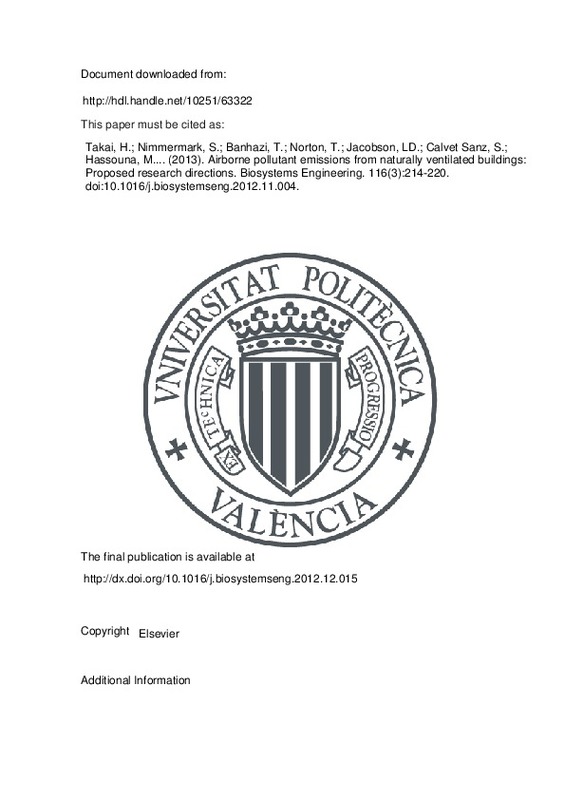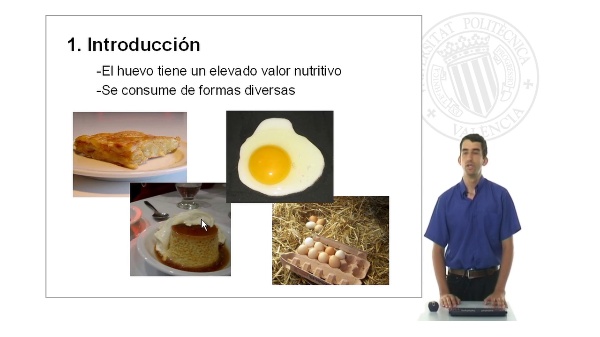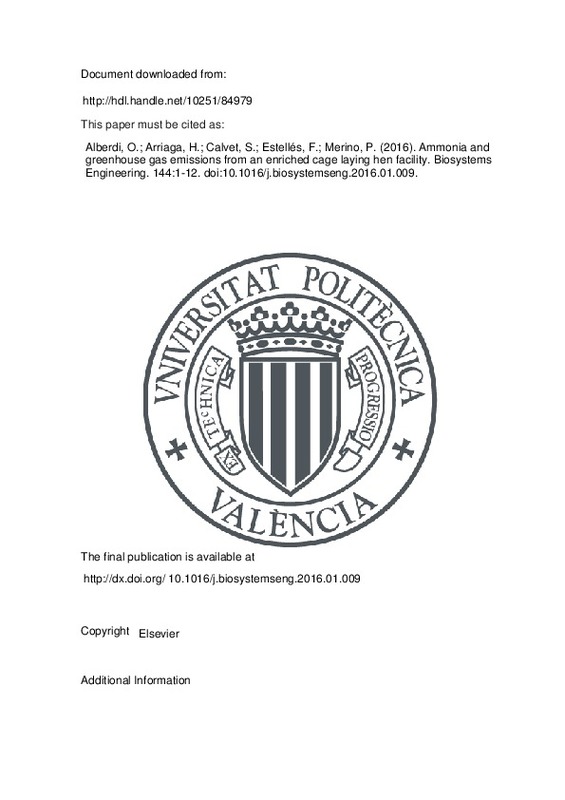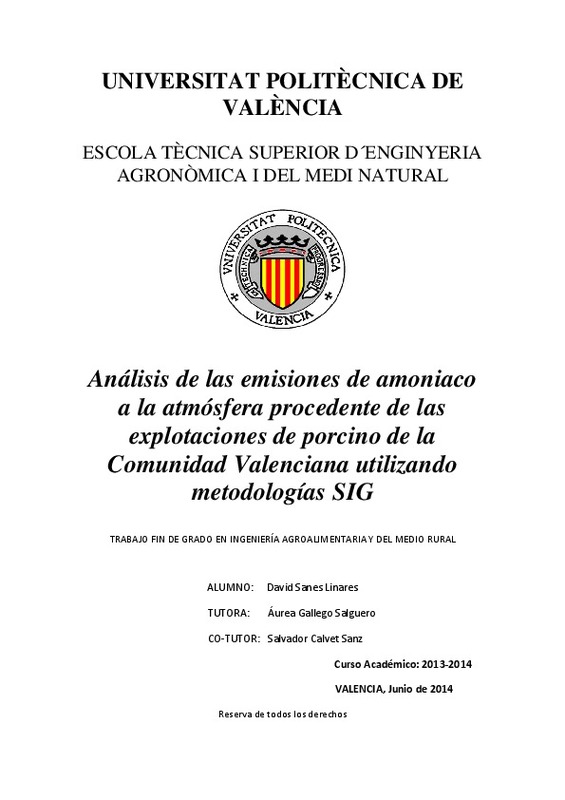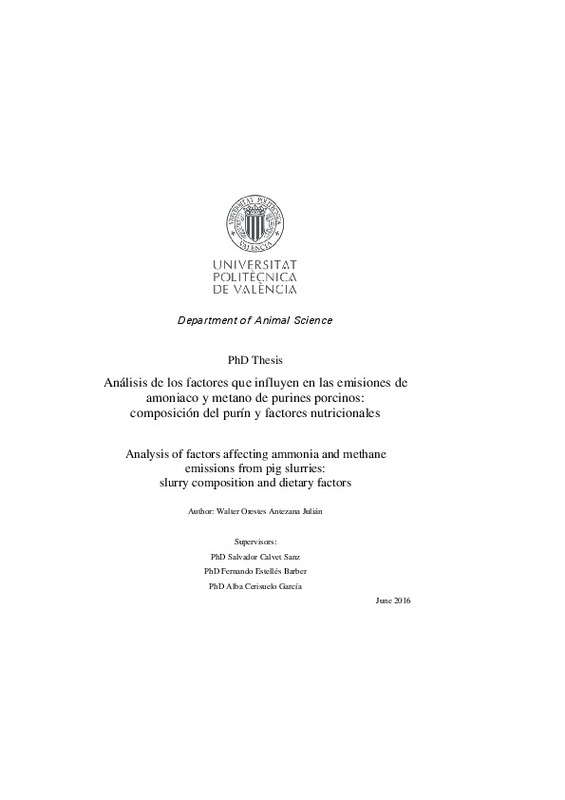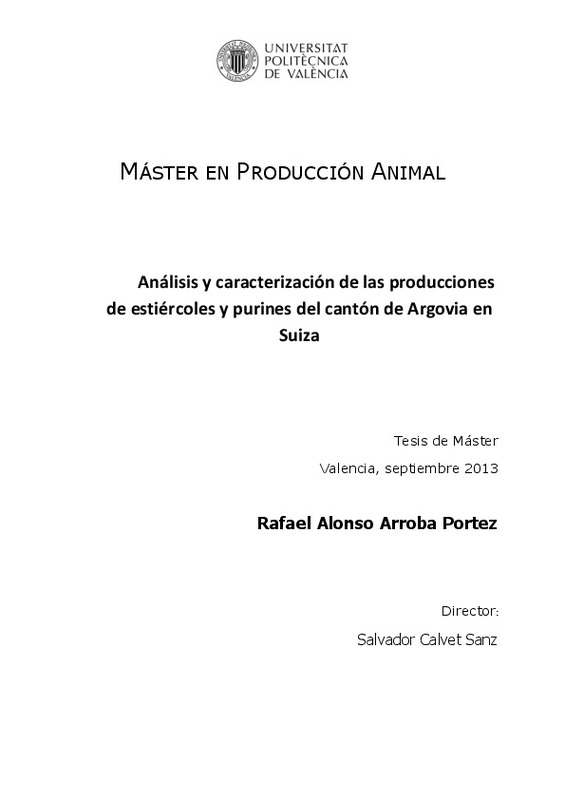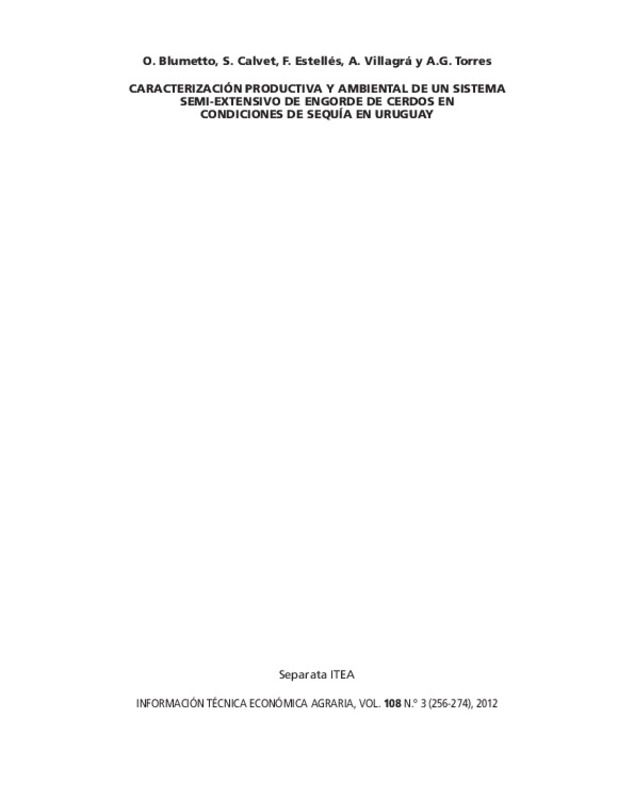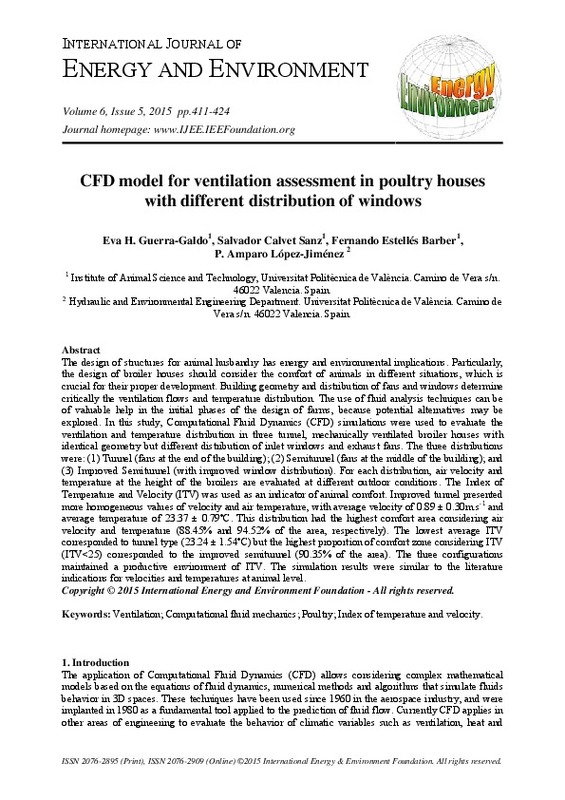

Listar por autor "Calvet Sanz, Salvador"
RiuNet: Repositorio Institucional de la Universidad Politécnica de Valencia
- RiuNet repositorio UPV
- :
- Listar por autor
JavaScript is disabled for your browser. Some features of this site may not work without it.
Buscar en RiuNet
Listar
Mi cuenta
Ayuda RiuNet
Admin. UPV
Listar por autor "Calvet Sanz, Salvador"
Mostrando ítems 1-20 de 127
-
Sanchis Jiménez, Elena María; Calvet, S.; Del Prado, Agustín; Estellés, F. (Elsevier, 2019-02)[EN] Livestock housing is one of the main sources of ammonia (NH3) emissions from agriculture. Different management and environmental factors are known to affect NH3 emissions from housing systems. The aim of this study ...
-
Calvet, S.; Arrufat, Begoña; Salaet, Ignasi; Atares, Sergio; Sobreviela, Ana; Herrero, Celestino; Romero, Joaquin; Estellés, F. (Elsevier, 2022-09)[EN] A urease inhibitor was tested in a naturally ventilated pig farm in summer conditions. In-time evaluation and case-control approach were used to assess the mitigation potential. Urease inhibitor reduced ammonia ...
-
Adell Sales, Elisa; Calvet Sanz, Salvador; Perez-Bonilla, Adriano; Jiménez Belenguer, Ana Isabel; Garcia, Julio; Herrera, Jorge; Cambra López, María (Elsevier, 2015-01)The application of disinfectant thermo-nebulised into the air of laying hen houses to reduce airborne microorganisms was evaluated with emphasis on its effect on Mycoplasma gallisepticum. Two air disinfectant tests were ...
-
Takai, Hisamitsu; Nimmermark, Sven; Banhazi, Thomas; Norton, Tomas; Jacobson, Larry D.; Calvet Sanz, Salvador; Hassouna, Melynda; Bjerg, Bjarne; Zhang, Guo-Qiang; Pedersen, Soeren; Kai, Peter; Wang, Kaiying; Berckmans, Daniel (Elsevier, 2013-11)The present article describes the current research focus and the future research trends associated with investigating emissions from naturally ventilated buildings as identified at the technical session entitled "Emission ...
-
Calvet Sanz, Salvador (Universitat Politècnica de València, 2009-06-01)Descripción general de los alojamientos para gallinas ponedoras, incluyendo las edificaciones, sistemas de suministro de pienso y agua, retirada de estiércol y recogida de huevo
-
Calvet Sanz, Salvador (Universitat Politècnica de València, 2009-06-01)Descripción de los sistemas de alojamientos para cría de cerdos en granjas comerciales e instalaciones básicas
-
Alberdi, O.; Arriaga, H.; Calvet, S.; Estellés, F.; Merino, Pilar (Elsevier, 2016-04)[EN] Ammonia, methane, nitrous oxide and carbon dioxide emissions were measured during a complete production cycle in an enriched cage laying hen facility under Oceanic climate conditions. Continuous monitoring of gas ...
-
Antezana-Julián, Walter Orestes; Ferrer Riera, Pablo; Cambra López, María; Estellés, F.; Calvet, S. (Springer-Verlag, 2016)[EN] Standardized measurement protocols are required to reduce ammonia (NH3) emissions. In vitro measurement of NH3 emissions consists in trapping the emission from an emitting source in an acidic solution under controlled ...
-
Sanes Linares, David (Universitat Politècnica de València, 2014-09-24)[ES] La ganadería intensiva tiene un elevado potencial contaminante y por ello está sujeta a normativa legal basada en la conocida como Directiva IPPC (del inglés, prevención y control integrados de la contaminación). Uno ...
-
Gabarda Inat, Alejandro (Universitat Politècnica de València, 2022-10-13)[ES] En los últimos años han surgido nuevas tecnologías y manejos para los ganaderos cuya finalidad es mejorar la sostenibilidad de las explotaciones. Sin embargo, la implementación de estas prácticas no siempre es ...
-
Rebollo San Segundo, Cristian (Universitat Politècnica de València, 2020-10-07)[ES] El presente TFM analiza la gestión y valoración del purín procedente de granjas porcinas de régimen intensivo, para lo cual se examinan diferentes proyectos llevados a cabo tanto por entidades nacionales como europeas. ...
-
Antezana Julián, Walter Orestes (Universitat Politècnica de València, 2017-06-22)[EN] This PhD Thesis focuses on characterizing potential emissions of ammonia (NH3) and methane (CH4) from pig slurries. In particular, it analyses the relationships between nutrient consumption and excretion, slurry ...
-
Gabarda Inat, Alejandro (Universitat Politècnica de València, 2022-09-19)[ES] Las actuales exigencias ambientales de la sociedad persuaden a los reguladores para que se tomen medidas al respecto y minimizar así el impacto de la producción. El sector ganadero no es una ex-cepción, y a los ...
-
ARROBA PORTEZ, RAFAEL (Universitat Politècnica de València, 2014-06-23)[ES] Mediante este trabajo se realizo un análisis de las producciones de estiércoles y purines del cantón de Argovia en Suiza en el año 2012 destacando algunas de sus características ganaderas. Utilizando datos estadísticos ...
-
Rosa, E.; Arriaga, H.; Calvet, S.; Merino, Pilar (Oxford University Press, 2018)[EN] Gaseous emission in laying hen facilities affects animal production performance and the environment. Emission is ruled by gas concentration and ventilation rate (VR), which are the key parameters to estimate precise ...
-
Barbosa, Leonardo V. S.; De Moura, Daniella J.; Estellés, F.; Ramon-Moragues, Adrian; Calvet, S.; Villagrá, Arantxa (MDPI AG, 2022-05)[EN] Simple Summary We used two commercial breeds, differing in growth rate: Fast-growing breed and slow-growing breed. We stocked these birds in two different densities. The slow-growing birds was stocked at a high density ...
-
Prieto Sancho, Roberto (Universitat Politècnica de València, 2014-09-25)[EN] Carbon dioxide (CO2), which is produced by animals and their manure, is one of the environmental control parameters inside livestock buildings. This gas can be used as an estimator of the ventilation needs and is also ...
-
Blumetto Velazco, Oscar Ricardo; Calvet Sanz, Salvador; Estellés, F.; Villagrá García, Aránzazu; Torres Salvador, Antonio Germán (Asociación Interprofesional para el Desarrollo Agrario, 2012)[EN] In Uruguay, different pig production systems coexist: confinement systems and pastoral systems. These systems differ in terms of production costs, animal welfare and environmental impacts. On the other hand, droughts ...
-
Calvet Sanz, Salvador (Universitat Politècnica de València, 2011-02-14)
-
Guerra Galdo, Eva Hilda; Calvet Sanz, Salvador; Estellés Barber, Fernando; López Jiménez, Petra Amparo (International Energy and Environment Foundation, 2015)The design of structures for animal husbandry has energy and environmental implications. Particularly, the design of broiler houses should consider the comfort of animals in different situations, which is crucial for ...
Mostrando ítems 1-20 de 127

Universitat Politècnica de València. Unidad de Documentación Científica de la Biblioteca (+34) 96 387 70 85 · RiuNet@bib.upv.es


